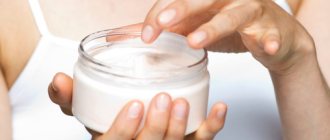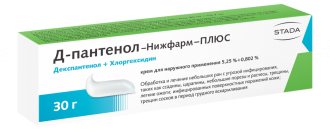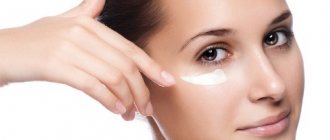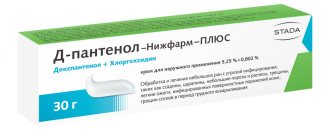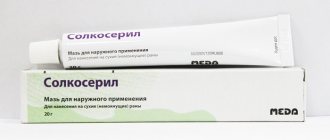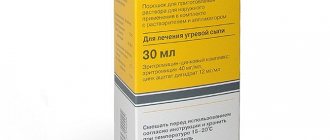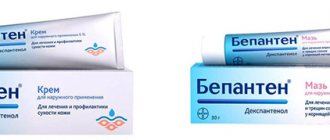Every person has encountered various types of skin damage more than once in their life. Such problems can be caused by a variety of reasons, ranging from domestic injuries to adverse environmental factors.
It is impossible to avoid skin injury in everyday life, but such damage can be treated. For this purpose, special creams and ointments can be used to heal wounds on the skin, which differ from each other in some characteristics. Before using this or that drug, you must read the instructions and consult your doctor.
How does a cream differ from an ointment, and an ointment from a gel?
The difference between cream, gel, balm and ointment is as follows:
- Cream is a dosage form based on oil and water. Creamy substances are easily absorbed, but are not able to penetrate deep into the tissue. They can be applied to surfaces that are constantly wet. In most cases, they are completely absorbed and do not stain clothes. You can rub the cream in and go about your business.
- The gel does not contain fats and oils, its acid-base indicators are close to those of the skin. It spreads easily over the skin, is quickly absorbed, and does not clog pores. Sometimes, after it dries, an airtight film remains (for example, Diclofenac). The structure of gel-like preparations can be liquid (for example, Troxevasin) or viscous. When stored in the refrigerator, they partially thicken, but when heated to room temperature, they restore their properties. Like creams, gels are convenient to use during the day.
- Ointment is a dosage form based on fats. It is absorbed more slowly than gel-like and creamy preparations, but it lasts longer. Penetrates deeply. It is applied to dry surfaces, scars, seals. Lubricated areas can be covered with bandages. The remaining fatty base usually has to be removed manually, so you need to apply ointment-like substances under clothing carefully. Some of them have a specific smell (for example, Vishnevsky ointment). The thickest ointments are called pastes. They contain up to 20% powdery substances. Most often they have drying properties.
- Balm is a medicinal or cosmetic product that contains no water at all. When you need to clarify what the difference is between a balm and a cream, this difference is given first. The absence of water allows balms to retain their properties for a long time. This is due to the fact that harmful bacteria multiply in water, and there is no natural habitat for them here.
Which is better, gel or cream, depends on the patient’s age and the condition of his skin.
The main difference between cream and ointment is the percentage of fat content. Something in between these substances in texture is called liniment. This dosage form contains fats and oils. If there is more fat, then the liniment resembles an ointment, if there is oil, it resembles a cream (for example, Synthomycin liniment). At body temperature, liniments begin to melt, so they are applied a little at a time so that excess medicine does not drip onto clothes and the floor.
External medicines.
Ointment, cream or gel are external medications that are used in modern medicine for various diseases. Today we will analyze one medicinal group - these are external agents used to treat diseases of the musculoskeletal system: osteochondrosis, arthritis, arthrosis, etc.
The most commonly used treatments for these diseases are:
- PAIN RELIEF ANTI-INFLAMMATORY MEDICINES are external medications that contain the active ingredients diclofenac, nimesulide, ketoprofen, ibuprofen, etc. They relieve inflammation, swelling and redness well. Significantly reduce joint pain and morning stiffness. You can read more about this group of drugs in this article - NSAIDs.
- HEATING PRODUCTS – external medications, the therapeutic effect of which is due to local irritation of skin receptors. By dilating blood vessels and increasing blood flow, nutrition of the affected joints improves, all metabolic processes are normalized and the patient’s condition significantly improves. As a rule, these ointments contain medicinal substances: capsaicin, nicoboxil, bee venom, snake venom, fir oil, clove oil, turpentine and others.
Very often, pharmacy visitors cannot decide what to buy: ointment, cream or gel. What is the difference between them and which helps better? So…
Is it possible to replace cream-type medications with ointment-type ones and vice versa?
What is better, ointment or cream, is decided by the doctor in each specific case. When it is not possible to obtain the required dosage form, the ointment can be replaced with cream. Replacement is possible in cases where the dosage of the active substance in the creamy medicine is the same or less than in the ointment. If the dosage is less, the cream will need to be applied more often (the number of additional procedures must be calculated in advance).
You cannot use ointment instead of cream. It is absorbed much deeper, so it can affect the “wrong” areas (for example, with a strong inflammatory process).
When replacing ointment with cream, pay attention to the concentration of the active substance.
Do not use different dosage forms at the same time. When mixed, their components may not provide the same effect as desired. If your treatment plan includes different medications and you are deciding whether to apply an ointment or a gel first, start with the gel-like substance. When it is completely absorbed and its expiration date has passed (usually 2-4 hours), clean the treated surface from the film as much as possible, then lubricate it with ointment. This is also true for creams that should be used before ointments.
Indications for use of the cream
Every day, facial skin is exposed to a variety of unfavorable factors that have a detrimental effect on its youth and beauty.
As a result of the constant influence of these reasons, insufficient fortified nutrition and improper care of the skin, it begins to deplete. The dermis loses its ability to regenerate tissue, its elasticity decreases, and the balance of substances deteriorates significantly. These symptoms are among the main causes of most difficulties in the structure and functioning of the skin.
When the skin looks quite bad, signs of overwork and lack of useful microelements are noticeable, you should use a cream.
The cream is used:
- Improved blood circulation;
- Activates metabolic processes;
- Tones;
- Increases elasticity;
- Removes street dirt and excess makeup;
- Restores acid balance;
- Softens the skin;
- Narrows the pores on the skin.
Gel and ointment - difference in shelf life
Expiration dates are usually given for sealed medications. As a rule, manufacturers write how long a substance can be stored unopened. In general, ointment-based preparations last longer than gel-based preparations because the fats they contain prevent drying out.
Store medications as recommended by the manufacturer.
When storing ointment, pay attention to the manufacturer's recommendations. In the refrigerator, the medicine can harden, and at a crucial moment you simply cannot get it out of the tube.
Gel-like preparations are more convenient to use than ointment-like preparations with a similar effect, and therefore cost a little more.
Comparison
The basis of all creams without exception is a mixture of water and oil. There are two types of emulsion: “oil in water” (contains up to 80% water) - when microscopic particles of fat are distributed in the aqueous phase, and “water in oil” (a rarer type, contains up to 70% fat) - when tiny droplets of water are dispersed in a fatty environment. To keep the emulsion particles as small as possible, emulsifiers are used - special substances that envelop them, preventing them from merging with each other. Traditionally, creams contain vegetable (for example, jojoba, almond, olive) or animal (lanolin, spermaceti) fats: cosmetics based on this are considered more expensive and are considered professional and medicinal. In recent years, more and more manufacturers have included synthetic mineral oils in creams - an inexpensive and easy-to-storage petroleum product. It is worth considering that mineral oils create an airtight film that does not allow the skin to breathe. They are poorly absorbed by the skin and have a comedogenic effect, which can provoke an allergic reaction and various rashes.
Cosmetic gel is a high-viscosity product based on water (70-80%). The gel may also contain glycerin (10-30%), gelatin (2-3%), gum arabic, starch, agar-agar, pectin, trehalose (a natural polysaccharide based on corn starch, which has a very high water-holding capacity). The gel does not contain oils or fats, and therefore it has a more delicate and light consistency, is absorbed faster and does not leave a greasy film on the skin. Due to these properties, the gel is perfect for oily, young, problem skin and fits well under makeup. With gel, the skin breathes better. This product has excellent moisturizing properties, so it is sometimes applied directly under the cream, which gives a more nourishing, protective effect.
Cream, as a denser, denser and richer product, can leave a slightly noticeable film on the skin after application. It is able to intensively nourish the skin and saturate it with useful substances. Therefore, the cream is ideal for dry, mature, aging skin. Around the eyes it is better to use a gel or a light cream-gel (3-5% oils), since a greasy cream can cause swelling on the eyelids. For problematic acne-prone skin, cream is also undesirable, because excess sebum accumulates on it.
Gels are recommended to be used mainly during the day, creams are good for intensive night nutrition and smoothing the skin. Gels are great for reducing daytime swelling of the face and tightening the skin; they have soothing, cooling and anti-inflammatory properties; they can be used for acne and seborrhea. Creams are better absorbed in the dark, during sleep, and the active substances from them are delivered to their destination more intensively.
Gel or ointment – which is better in emergency situations?
The gel is absorbed much faster than ointment. Therefore, in a situation where you urgently need to relieve pain, for example, a joint, it acts faster. If you need to provide a longer analgesic effect, relieve inflammation, ointment is preferable.
In addition to the duration of action, the list of ways in which an ointment differs from a gel includes the ability to adhere to the surfaces being treated. Gel-like medications adhere better to wet, wet surfaces, from which ointment-like medications simply slide off.
In general, ointment can penetrate deeper than gel. However, some gel preparations (for example, Traumeel) contain additives that ensure deep penetration of the main active ingredient. Then the difference between gel, cream and ointment is insignificant.
Gels and creams act faster, ointments last longer.
Comparison
Both gel and ointment consist of a base and active medicinal substances. But if ointments are produced primarily on a fat basis (vaseline, lanolin, vegetable oils, purified lard, grease (petroleum oils), naphthalan), then gels do not contain fats at all, they are created on a water base. The ointment is a colloidal solution when the particles of the active substance are not completely dissolved in the base. The gel consists of 70-80% water and thickeners, so the active ingredient in it, unlike ointments, is usually completely dissolved in the base. Due to the fact that the gel is absolutely non-greasy, it can be easily washed off the skin if necessary, and can also be quickly and easily washed off with water if it accidentally gets on clothes.
The gel, compared to the ointment, has an acidity (pH level) close to the acidity of healthy skin, therefore it is considered a more physiological product. In addition, when applied, the gel does not clog pores; due to its elastic, plastic, elastic consistency, it is easily, almost instantly distributed over the skin. The ointment is gradually distributed and absorbed much more slowly. The gel has both drying and liquid-saturating properties (hydrophilic) to the skin. It usually quickly forms a thin film and adheres well to the skin and mucous membranes. The ointment most often has a moisturizing effect, but when a layer of this drug is applied to the skin and mucous membranes, some time must pass before it is completely absorbed. Otherwise, with a careless movement, a carefully applied layer of ointment can simply be “smeared” from the skin, and the drug will have to be applied again. Fatty ointment is good for flaky skin wounds, it will soften them perfectly, and gel is more suitable for wet wounds - it will dry them out and, thanks to the thin impenetrable film that forms, will protect them from the penetration of bacteria and viruses.
The ointment is more viscous than the gel. Due to the fact that the ointment is made on a fat basis, it can become unusable faster than a gel, because vegetable oils tend to go rancid in air.
Gel or cream – which is better to use for cosmetic purposes?
Cosmetics for hands, face and body are also made in the form of gels and creams.
- Cosmetic gel consists of 75−85% water. The remaining 15−25% are microparticles with the ability to retain moisture and other special properties. The high water content allows gel-like products to be easily absorbed into the skin, perfectly moisturize it, and avoid the formation of an unpleasant greasy film. They are recommended for young, combination, oily and problematic skin.
- Creams contain much less water than gel products. But they contain a lot of oils that provide different effects: nutrition, whitening, smoothing out fine wrinkles, etc. Creamy products are suitable for mature, dry and combination skin. They often leave an oily sheen and may not be completely absorbed. It is dangerous to apply them to problem skin - fats can clog pores and provoke even greater inflammation.
Problem skin loves gel, while normal skin loves cream.
The main difference between gel and ointment and cream is the time of use: gel-like substances are best used in the morning and afternoon, and cream-like substances are best used before bed. There are day creams, which are similar in structure to a gel, and night creams, which are more like an ointment.
Types of wounds
The choice of wound healing agents primarily depends on the type of wound itself and its characteristics. The current classification implies the following points:
- Nature of damage. In this case, we mean the conditions under which the injury occurred. According to this parameter, wounds are cut, chopped, punctured, bruised, etc.
- Microbial contamination. The presence of microorganisms in the wound is accompanied by its suppuration. Local reactions in the form of inflammation and increased tissue temperature are also possible. In such cases, it is necessary to use an ointment for healing wounds and cuts with antibacterial components. Clean wounds are also called aseptic wounds. In this case, there is no talk of microbial contamination. This means there is no need to use antibacterial ointment to heal wounds and cracks. It is enough to limit ourselves to other groups of drugs.
Damage to the skin can develop as a result of household trauma (cuts), exposure to external physical (burns, frostbite) and chemical factors, as well as in the presence of concomitant diseases (ulcers, bedsores, erosion). In each case, it is important to choose the appropriate healing ointment for cuts and wounds and use it correctly.
Benefits of Skinoren
There is a wide variety of drugs based on azelaic acid that are successfully used to treat skin pathologies. The most popular analogues of Skinoren in our country are Azogel and Azelik gels (Russia), as well as Azix-derm (India) and Acne-derm (Poland) creams. The concentration of the active component coincides with the German development, but the composition of the excipients is somewhat different.
The main advantages of the drugs over analogues:
- Milder effect (does not cause excessive dryness and irritation).
- There is no increase in sun sensitivity, so there is no need to combine with sunscreens.
- Can be used both for the treatment and prevention of skin pathologies.
- Easy to use.
- Lower price.
It should be noted that there are cheaper analogues, but their effectiveness, according to experts and patient reviews, is much less.
Overall effect
Treatment of dermatitis
These formulations of the drug are used to treat non-infectious skin diseases. These include:
- Dermatitis of various origins.
- Psoriasis.
- Eczema.
- Certain types of lichen.
- Lupus erythematosus.
- Sunburn.
This is any inflammation of the skin that is accompanied by itching and redness. Neither cream nor ointment can cope with viral and fungal infections. They cannot cure herpes or chickenpox.
Used for the treatment of childhood rashes. Just be careful! Do not apply several times a day or use for a long time. Hormones can affect the nervous system and the functioning of the adrenal glands. Suitable for children from 2 years old. It is contraindicated to treat diaper rash with Elok cream and ointment.
High efficiency
Both drugs are strong. Relieves grade 3 inflammation, which spreads to large areas of the skin and occurs with intense itching. Many people are put off by the hormone levels. However, having tried many ointments, they return to these products. They include a potent synthetic hormone of the adrenal cortex - glucocorticosteroid. The composition is designated as mometasone furoate. Thanks to him, the problem is solved immediately. The enzyme instantly penetrates the skin and has a local effect:
- Anti-inflammatory.
- Decongestant.
- Antipruritic.
It is excreted from the body in urine and feces.
The high effectiveness of the products is confirmed by many positive reviews. The result is achieved 8 hours after application. However, everything is subjective and depends on the severity of the symptoms. In some patients, a decrease in itching and redness was observed after 15 minutes, in others - 2 hours, in others - 8 hours.
External use
Elokom cream and ointment are applied to the inflamed area once a day in a thin layer. Doesn't rub in.
The duration of treatment is until control occurs. Determined individually. Depends on the disease itself, age and severity of symptoms. However, there is a duration limit: no more than 3 weeks. If there is no improvement within 14 days, stop using it and contact a dermatologist to clarify the diagnosis.
Occurrence of side effects
It is not recommended to use both forms of the drug for a long time and several times a day. This leads to unwanted side effects:
- Itching.
- Burning.
- Dryness.
- Rashes.
- Skin atrophy.
- Severe redness.
- Secondary infection.
In the first days, itching and burning are possible. This is a normal reaction of the body to the contained hormone. They do not serve as a basis for stopping treatment. Such side effects go away on their own.
Using drugs for a long time, their effectiveness decreases, hormones accumulate in the body. Sometimes serious complications arise. Dermatitis not only does not go away, but also manifests itself more strongly. Contraindicated for use in a wide area of distribution.
